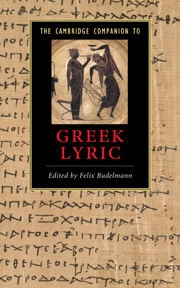Book contents
- Frontmatter
- Introducing Greek lyric
- Part I: Contexts and topics
- Part II: Poets and traditions
- 8 Iambos
- 9 Elegy: Forms, functions and communication
- 10 Alcman, Stesichorus and Ibycus
- 11 Alcaeus and Sappho
- 12 Anacreon and the Anacreontea
- 13 Simonides, Pindar and Bacchylides
- 14 Ancient Greek popular song
- 15 Timotheus the New Musician
- Part III: Reception
- Chronology of select melic, elegiac and iambic poets
- Further Reading
- Glossary
- List of works cited
- Index
10 - Alcman, Stesichorus and Ibycus
from Part II: - Poets and traditions
Published online by Cambridge University Press: 28 May 2010
- Frontmatter
- Introducing Greek lyric
- Part I: Contexts and topics
- Part II: Poets and traditions
- 8 Iambos
- 9 Elegy: Forms, functions and communication
- 10 Alcman, Stesichorus and Ibycus
- 11 Alcaeus and Sappho
- 12 Anacreon and the Anacreontea
- 13 Simonides, Pindar and Bacchylides
- 14 Ancient Greek popular song
- 15 Timotheus the New Musician
- Part III: Reception
- Chronology of select melic, elegiac and iambic poets
- Further Reading
- Glossary
- List of works cited
- Index
Summary
Introduction
[Translated from the German by Sira Schulz] The poets Alcman, Stesichorus and Ibycus lived between the late seventh and the late sixth century BCE. Their geographic origins span an area stretching from islands off the coast of Asia Minor to the Peloponnese and all the way to the Greek colonies of southern Italy and Sicily. Their activities belong to the age of the rise of the polis, one of great economic prosperity and expansive trade relations which led to familiarity with distant cities and their luxury goods and are reflected in the mobility of these poets. It is also the time of a well-developed music and festival culture closely connected to the institution of the polis and its need for representation: symposia, religious festivals and musical competitions (agônes mousikoi) provide a solid framework within which poetry is performed and circulated. The shared cultural environment of the three poets is manifest in the common subject matter of their poetry, which tells of magnificent festivities, horses and riches, and often establishes a close connection between the present and a glorious past - in Alcman this past is more local, mythic and cultic, while in Stesichorus and Ibycus it reflects the formation of a panhellenic identity. Their mythological and Trojan stories serve to develop this identity further and often have an encomiastic objective when they establish an immediate connection between past and present, so that the heroic past forms a grand backdrop to current events. All three poets compose in the Doric dialect (Alcman with local Laconian influences) and employ the triadic structure in their choral odes (Alcman only uses an early form of the triad). The wide scope of panhellenic communication becomes apparent in the poets’ mobility. Alcman was said to have come from Sardis to Sparta, just as Terpander had arrived there from Antissa on Lesbos about fifty years earlier.
- Type
- Chapter
- Information
- The Cambridge Companion to Greek Lyric , pp. 189 - 203Publisher: Cambridge University PressPrint publication year: 2009
- 3
- Cited by

